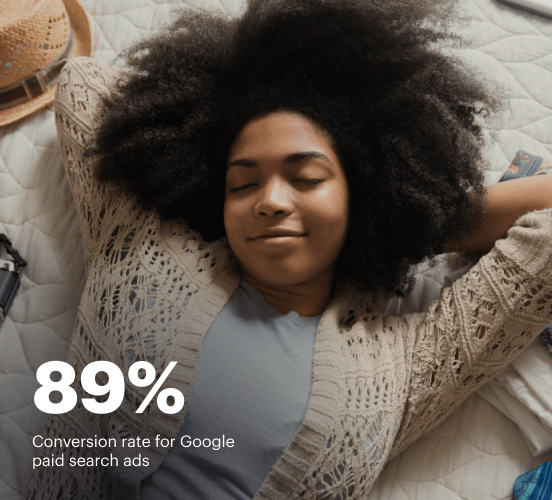How Shopify vs. Emma vs. Instapage stack up against each other
Compare Instapage with Shopify and Emma to create high-converting landing pages. With personalization, optimization, and collaboration tools, Instapage helps you deliver experiences that drive results.
Get startedSee how Instapage stacks up against the competition
| Feature | Instapage | Other builders |
| Drag-and-Drop Tools | ||
| Conversion-optimized templates | ||
| Manual and AI-powered A/B Tests | ||
| AI content suggestions | ||
| Popups and sticky bars | ||
| Canvas and grid blocks | ||
| Reusable and global elements | ||
| Form and popup builders | ||
| Built-in Heatmaps | ||
| Central analytics dashboard | ||
| Ad-to-page personalization and collections | ||
| Contacts, lists, and email | ||
| Dedicated, full-service CRO experts | ||
| Enterprise-ready platform |
Leading the way in building high-performing landing pages





Why Instapage is the smarter choice for your campaigns
Get everything you need to build, scale, and optimize high-converting landing pages—without coding.

Easier page building without coding
Instapage offers a flexible and seamless page creation experience with a library of 500+ conversion-focused layouts, Instablocks®, a drag-and-drop builder, and AI content generation. With technologies like Thor Render Engine®, you can create on-brand, mobile-responsive landing pages that load quickly and start converting during initial visitor clicks.

More insights — better results
Instapage lets you see in detail how each landing page experience and variation is performing so you can make targeted changes that boost page conversions. Use heatmaps for a better understanding of on-page activities, run A/B tests and AI-assisted experiments, and then track and evaluate results within robust analytics dashboards.

More personalized experiences
Instapage lets you quickly create high-performing landing pages tailored to each of your ad campaigns. Deliver personalized experiences for distinct audiences using dynamic text replacement. Effortlessly align specific advertisements to unique pages with AdMaps. Monitor audience-level metrics using our advanced data tools.

Built-in collaboration
Instapage collaboration capabilities bring your entire team together to speed up the process of landing page review, approval, and launch. No more frustrating and unnecessary revisions or edits scattered across emails. Provide instant feedback, conduct real-time page edits, and securely share your pages with outside stakeholders.

Free up time for your business
Invest time into business growth, not busy work. Launch landing pages faster with reusable forms and templates. Build once, reuse forever.
Explore all integrations






Easier page building without coding
Instapage offers a flexible and seamless page creation experience with a library of 500+ conversion-focused layouts, Instablocks®, a drag-and-drop builder, and AI content generation. With technologies like Thor Render Engine®, you can create on-brand, mobile-responsive landing pages that load quickly and start converting during initial visitor clicks.
More insights — better results
Instapage lets you see in detail how each landing page experience and variation is performing so you can make targeted changes that boost page conversions. Use heatmaps for a better understanding of on-page activities, run A/B tests and AI-assisted experiments, and then track and evaluate results within robust analytics dashboards.
More personalized experiences
Instapage lets you quickly create high-performing landing pages tailored to each of your ad campaigns. Deliver personalized experiences for distinct audiences using dynamic text replacement. Effortlessly align specific advertisements to unique pages with AdMaps. Monitor audience-level metrics using our advanced data tools.
Built-in collaboration
Instapage collaboration capabilities bring your entire team together to speed up the process of landing page review, approval, and launch. No more frustrating and unnecessary revisions or edits scattered across emails. Provide instant feedback, conduct real-time page edits, and securely share your pages with outside stakeholders.
Free up time for your business
Invest time into business growth, not busy work. Launch landing pages faster with reusable forms and templates. Build once, reuse forever.
Explore all integrationsGet started with Instapage in a few steps
-
Create your Instapage account
Start with Instapage by signing up via Google or your email. You'll get access to a free 14-day trial to discover Instapage capabilities. Feel free to cancel anytime during the 14-day trial if you decide that our product is not suitable for your business. -
Build and personalize your page
Create your first landing page from scratch or choose a template from 500+ customizable layouts. Use the drag-and-drop builder to add page elements, fonts, and backgrounds, refine content with AI, or add custom HTML, Javascript, and CSS. -
Review and make edits
Collaborate on page designs and streamline review processes. Invite your team members and stakeholders to review, edit, and provide feedback on your landing page. Collaborate knowing your page is confidential and only accessible to authorized users. -
Publish and track page performance
Publish your page to a domain or custom URL. Connect your pages to the ads you've created and track page performance within the analytics dashboard, run A/B tests and AI experiments, analyze results, and continuously optimize your landing page to maintain high conversions.
Instapage vs. Shopify vs. Emma – Which Platform is the Best Fit for Marketers?
Choosing the right landing page builder can be likened to assembling your ultimate marketing dream team. Each option has its unique strengths, capabilities, and personalities. In this engaging comparison, we'll explore Instapage, Shopify, and Emma—three notable contenders that help marketers create effective landing pages. With their distinct features catering to various needs, our evaluation isn't just about ranking but about guiding you to the best fit for your marketing arsenal. At the heart of our discussion is Instapage, a platform that empowers marketers to reduce costs, grow conversions, and deliver relevant landing page experiences that foster brand trust and customer loyalty. As we compare these platforms, we'll uncover how each can help you boost your conversion rates and enhance your digital marketing efforts. Hold tight for an insightful journey through the ups and downs of these prominent players in the landing page sphere.
Introducing the Competitors: A Friendly Matchup
In the blue corner, we have Instapage, a platform known for its robust customization options and advanced conversion optimization tools. It positions itself as a marketer's best friend, allowing users to craft tailored landing pages that resonate with their audience. In the red corner, Shopify has made its mark primarily as an e-commerce giant but has extended its capabilities to include landing page functionality, making it a contender for those looking to sell products directly. Finally, in the green corner, we welcome Emma, an email marketing expert that enhances its offering with landing page capabilities that work seamlessly with its email campaigns. All three platforms offer unique features that cater to different marketing objectives, making this a competition worth watching as we dive into their individual strengths and weaknesses.
Feature Showdown: A Closer Look at Unique Offerings
Spotlight on Template Variety and User Experience
When it comes to templates and ease of use, each contender has its distinct lineup. Instapage offers an extensive library of customizable templates designed for optimal conversion. It's user-friendly interface allows marketers to create landing pages efficiently, even if they lack technical skills. Shopify, while primarily an e-commerce platform, offers templates that are beautiful and designed to drive sales; however, they may be less customizable compared to Instapage. Emma also provides a selection of templates catered to email marketing but may not have the dedicated focus on conversion that Instapage specializes in. Overall, Instapage stands out in terms of variety and ease of customization, positioning itself as the go-to option for marketers focused on optimization.
Instapage: Champion of Customization and Conversion Focus
Instapage shines brightly with its superior customization and conversion optimization tools that set it landscapes apart from its competitors. The platform allows users to easily tailor landing pages to align with specific campaigns or promotions. Features like A/B testing and heatmaps provide valuable insights into user behavior, empowering marketers to make data-driven decisions that enhance the performance of their landing pages. By focusing on delivering relevant landing page experiences, Instapage helps brands build trust and customer loyalty. The platform’s intuitive drag-and-drop editor streamlines the design process, allowing users to focus on creating stunning layouts that drive conversions rather than getting bogged down by technical hurdles. Marketers can optimize every aspect of their landing pages to ensure peak performance. Additionally, the built-in analytics offered by Instapage enable marketers to track the effectiveness of their campaigns, positioning it not only as a tool but as a long-term partner in achieving marketing success.
Speed and Performance: The Race to the Top
Let's take a moment to engage your imagination: think of website speed as the friendly barista at your favorite coffee shop. If they’re slow, it can turn your excitement for that perfect cup into a frustration. Just like customers appreciate speedy service, your landing pages must load quickly to ensure a fantastic user experience. Slow-loading pages can lead to high bounce rates and lost conversions, making speed a crucial factor in choosing your platform. As we delve into each contender's performance metrics, we hope to unveil who’s truly in the fast lane.
Advantages of Instapage Regarding Speed and Performance
- Instapage utilizes optimized hosting, ensuring minimal loading times for landing pages.
- The platform’s lightweight code structure contributes to faster page rendering.
- Instapage’s powerful performance tracking tools provide insights that help further enhance speed.
- Users can easily manage and optimize media assets to minimize delays during loading.
Advantages of Shopify Regarding Speed and Performance
- Shopify benefits from high-performance infrastructure designed for e-commerce activity.
- The platform leverages content delivery networks (CDNs) to enhance speed.
- Shopify regularly updates its features to ensure optimal performance for users.
Advantages of Emma Regarding Speed and Performance
- Emma employs optimized loading techniques for its landing pages.
- The platform offers convenient integration with email marketing, promoting smooth user experiences.
- Regular updates keep Emma’s performance in check, offering reliable services.
- Emma’s templates are designed for fast loading without compromising aesthetics.
In conclusion, when it comes to speed and performance, Instapage offers exceptional advantages that can significantly influence conversion rates. With optimized hosting and a focus on lightweight code, it consistently exceeds performance expectations. While Shopify and Emma certainly have their merits, Instapage remains unmatched in its capabilities to enhance user experience through speed. Thus, for marketers seeking to make the most of their landing pages, Instapage proves to be the right choice.
Navigating Usability: Learning Curve and User Experience
When assessing usability and the learning curve, it's essential to consider how friendly these platforms are to both newcomers and seasoned marketers. Instapage takes pride in its intuitive design, which allows even those with little technical experience to jump right in and start creating stunning landing pages. The platform provides extensive resources, including tutorials and a supportive community, making it easy for beginners to build their skills. Shopify also features an intuitive dashboard, though users might experience a steeper learning curve as they navigate through its many e-commerce functionalities. Emma, on the other hand, is user-friendly particularly for those familiar with email marketing tools; however, the transition to its landing page functionalities may require some adjustments. Overall, all three platforms are designed to empower users, offering varied levels of support, but Instapage stands out for its comprehensive user orientation.
The Support Team: Who’s Got Your Back?
Imagine your customer support team as your loyal sidekicks, always ready to assist when challenges arise. Instapage offers robust support through live chat, email, and a rich knowledge base that ensures users receive quick help whenever they need it. Their community forums are an additional resource where users can share insights and solutions. Shopify's support is equally competent, providing 24/7 assistance via chat and phone. The wealth of resources they offer, including detailed help documents and forums, means users rarely feel stranded. Emma promotes seamless support through live chat, email, and tailored onboarding experiences for new customers, ensuring they feel confident using the platform. While all three contenders boast strong customer support, Instapage's diverse offerings and community engagement foster a collaborative atmosphere that users appreciate.
Pricing Strategies: Evaluating Cost vs. Value
Pricing is a pivotal consideration in the decision-making process, and each platform’s pricing strategy reflects its unique value propositions. Instapage operates on a subscription model that offers a variety of plans tailored to different needs, all of which focus clearly on landing page functionality. Shopify has tiered pricing that can vary significantly depending on the additional e-commerce features utilized, which might be ideal for businesses primarily focused on online sales. Meanwhile, Emma embraces a pricing structure based on email marketing services with integrated landing page functionalities, catering mainly to brands that prioritize email marketing. Understanding the costs versus the benefits each platform provides will help readers make informed decisions based on their specific marketing goals and budget.
In conclusion, the comparison of Instapage, Shopify, and Emma highlights that the best choice relies heavily on your unique needs and goals. These platforms have their individual strengths, but Instapage shines brighter in the realms of customization, conversion optimization, and user-friendly support. We encourage you to give Instapage a chance through a free trial or demo and see how its powerful features can elevate your marketing strategy!










